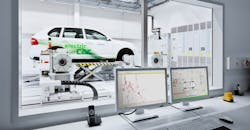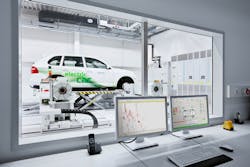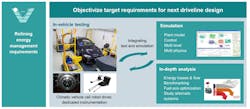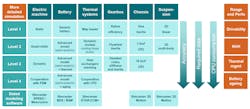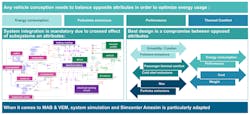The monumental task of building the electric vehicle falls on a series of complicated tasks, compromise, and patience. The company that can best solve the energy-management issue will likely find higher levels of success and win a greater percentage of market share.
Over 200 electric-vehicle models are expected to enter the market over the next three years. Startups will probably choose new platforms to build their vehicles, whereas OEMs will likely produce on conventional vehicle platforms. With new technology continuing to evolve, there’s no clear front-runner.
It’s considered that the road to electrification will run through hybridization. Hybrid powertrains, though, are more complex than those with a single energy source, such as a conventional vehicle or electric vehicle. It will be the engineers’ responsibility to balance the power delivered by each energy source to its intended attribute. This involves trading off between several physical domains like electrochemistry for the battery, electrics for the electric machines, mechanics of the transmission, and thermal aspects related to the controls.
It's then a matter of using the tools available to either make the necessary changes that will minimize a vehicle’s fuel consumption or find ways to remove it altogether and replace them with electrification. Many of the first steps toward optimal vehicle energy management include reducing engine size by electrifying the powertrain. Changing one attribute, though, can impact the rest of the vehicle.
That's why it’s imperative for engineer and design teams to break down their silos and work collaboratively. This ensures that they can easily monitor alterations, share information, and validate their findings.
Trial and Error
Complex systems and subsystems need verification and validation. Meanwhile, prototyping grows increasingly resource-intense, draining the budgets of the engineering and design teams and delaying the introduction of new products to market. To remain competitive, testing and troubleshooting new products in a simulation environment while they’re still in the development phase is crucial (Fig. 1).
1. Testing in a simulated environment as early as possible minimizes the need for costly prototypes and allows for design changes earlier in the design cycle.
China-based BAIC Motors used model-based systems engineering to run several driving cycles, testing frequent speed changes and constant speeds over longer periods. Using simulation and virtual evaluation, they successfully processed the data in multiple scenarios. By simulating various environmental factors such as extreme heat and cold, they were able to optimize the energy-management needs of the vehicle and meet fuel standards.
“The simulated driving cycles resembled the previously test recorded vehicle behavior meticulously. Looking at the graphs, we were truly impressed by the simulation solution,” stated LV Yuan, engineer in the powertrain integration department of the R&D Center at BAIC Motor Corporation Ltd.
Simulation tools, using 1D, 3D, and CFD modeling, allowed BAIC Motors to better manage its time, money, and other resources to refine its development process, address previously ignored problems, and build a more fuel-efficient vehicle.
Vehicle Electrification Through Simulation
Vehicle engineering has become increasingly complex because more systems must interact together. On top of that, competition continues to grow. There’s a greater need for more cost-effective products, a reduction in time-to-market, and more vehicle variations due to regional regulations. Also, evolving customer demands have changed the way engineers think and design a car.
But in this context, how do you deploy new technology that enables engineers to cope with those challenges, without paying the price for it? When opting for a battery over fuel use, serious and complicated drawbacks arise. Each attribute affects another attribute or subsystem. For example, the speed of acceleration or level of passenger comfort both impact range.
Involving a holistic digital twin in every step of the process from ideation to realization allows manufacturers to use simulation to design the electric vehicle and ensure optimal energy management. Via IoT capabilities, the data is consistently fed back in a closed-loop system and used to improve vehicle design. Testing performance in real-world conditions through simulation lets engineers see how any number of factors, such as extreme heat and cold or the energy required to travel up a hill, impacts performance (Fig. 2).
2. Combining real-world testing with simulation provides further analysis on vehicle performance.
Also, engineers can implement multiple-systems analysis, providing a comprehensive look at a relatively efficient cost. The benefits are monumental when compared to analyzing a single component. Running simulation and virtual evaluation that accounts for every attribute and subsystem is significantly cheaper and less time-consuming than building a prototype. Integrating these factors into a single process provides optimal results quicker.
Just like BAIC Motors was able to do, manufacturers can reach higher levels of innovation by exploring new ideas and testing different designs without incurring the costs or time constraints that once held them back.
A Car on Fire Doesn’t Work
Each introduction of technology has drawbacks that need to be addressed. To solve this problem, a balance must be made between attributes, such as comfort, drivability, range, power or safety, and subsystems like battery packs, electric motors, cooling systems, electrical architecture, and on-board systems. These key attributes are directly connected with market positioning. But the variety of possible architectures makes finding the right balance from a variety of possible architectures challenging and remains at the heart of development.
Thermal management, for instance, is a challenge engineers face as they implement newer battery designs and electrification throughout the vehicle. Batteries suffer from a limited range of working temperatures, making overheating or burns a real concern. Along with an efficient cooling system designed for conventional engine and cabin comfort, controlling and moderating the temperature of the electrical platform is critical. Simply put, a car doesn’t work if it’s on fire.
To overcome these challenges, engineers must put in place multi-level modeling technology so that they’re using the right model at the right time. Accuracy speeds up time-to-market, decreases costs, as well as enhances the overall safety and integrity of the product.
It’s critical, then, to find the right model to answer the question posed by an engineer, regardless of the type of question or concern. Achieving accurate and specific results in a multi-level modeling platform requires more data and computing power for each ascending level. Level 1 is the basic level where, for example, a battery design is analyzed in its generic form. Level 4 is where analysis includes advanced modeling combined with thermal and aging (Fig. 3).
3. The level of simulation to test various interactive systems depends on available data, accuracy of analysis, and CPU consumption.
By putting the battery in real condition simulation, it’s possible to determine how the battery will perform and if it would exceed the power cycle. Simulating the environment and conditions allows checks for safety, performance, durability and limitations.
Answering specific questions can involve any variety of levels. Level 1 analysis of range and performance across a variety of subsystems like electric motor, battery, chassis, gearbox, and driveline may be sufficient. Analysis of thermal management, however, may involve a series of components in different levels of advancement. For example, an engineer might need to simultaneously scrutinize the battery at a more advanced level than the engine.
When the next critical question arises, or when the time comes to build a new model, each subsystem can be included without the need to build everything from scratch. This allows for continuous workflow with a single tool.
Simulation and virtual evaluation help discover and solve the issues. But what about sharing information?
Many manufacturers struggle to break the silos that prevent ease of communication. Operating in a waterfall development cycle means waiting for the previous design plan to complete their tasks or update information before continuing. It’s laborious and slows down the process.
Continuous model exchange means opening doors to communication and models. Whether it’s systems, subsystems, or control, information arrives faster providing more details in each model. This agile model ensures each design team is maximizing their ability to work smarter.
Turn Complexity into Simplicity
Vehicle electrification design requires managing several domains of physics and involves the collaboration of different experts at different stages of the design cycle. Innovation requires these experts to overcome complexity and manage risks. Simulation and validation tools will add simplicity to a complex process. In turn, complicated design changes can be implemented before physical prototypes.
Regardless of the kind of vehicle the manufacturer intends to produce, deciding on changes earlier in the design cycle will make it easier and more cost-effective to implement. Simulation, verification, and validation can ensure system continuity, multi-domain traceability, and functional safety across domains. This will help make the right tradeoff analysis and compromise between attributes and allow for more efficient integration (Fig. 4).
4. System integration is mandatory, but balancing attributes poses a whole host of challenges in the design process.
For success, look no further than the Renault-Nissan Alliance Group with its Test and Digital Engineering department, which uses computer-aided-engineering (CAE) methods and numerical models to innovate. How did they get to the point of encompassing 70% of the world’s electric-vehicle market? The engineers have the tools to quickly confirm fuel-consumption targets and test in multi-physics simulation environments.
For the cost-conscious consumer, Renault-Nissan uses simulation to ensure that they can build the architecture around the needs of the vehicle and optimize it based on targets such as size, weight, cost, and even technology—all of which impacts the cost of the vehicle and the level of energy consumption.
Finally, simulation doesn’t have to end once the vehicle hits the road. The same models used to design more efficiently can complement real-life testing if manufacturers can gather feedback. When vehicles are on the road, there’s a wealth of continuous data that can provide insight in driver behavior and usage. As development teams receive more data, engineers can use this information to evolve the current vehicle model and architecture into a more efficient, customer-focused electric vehicle.
Lionel Broglia is a Siemens Digital Industries Software business development manager for system simulation activities.
About the Author
Lionel Broglia
Business Development Manager
Lionel Broglia is a Siemens Digital Industries Software business development manager for system simulation activities in various sectors, including automotive and transportation, with a specific focus on electrification. He’s been involved in multi-domain system simulation since 1999, and has held several positions such as technical sales, account manager, technical marketing, product manager, and now business development manager.
